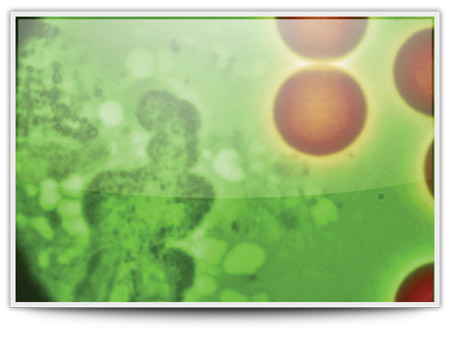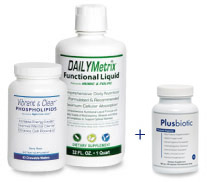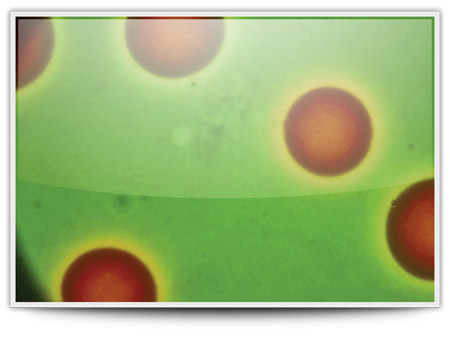Plusbiotic
Benefits | Candida | Ingredients | Soild Based | FAQ | Label Facts

PLUSBIOTIC benefITS INCLUDE:
-
Advanced Microflora Delivery
-
Beneficial Microflora Colonization
-
Healthy Fungal Levels
-
Normal Digestive Permeability
-
Intestinal/Digestive Cleansing
-
Optimal Nutrient Absorption
-
Healthy Immune Function
-
Stabilized Bowel Function
Plusbiotic Supports Intestinal
Balance and is a Powerful, But
Gentle Yeast Cleanse
Probiotics, also known as friendly bacteria may positively affect the balance of intestinal microflora, promote normal levels of bacteria and yeast colonies, promote good digestion, and support immune function and immune defenses.
Plusbiotic’s popular formula assists in supporting a healthy balance of intestinal flora where a yeast or fungal overgrowth is present. The addition of systemic enzymes help to improve elimination of toxins that can cause "die-off" symptoms. This makes Plusbiotic a more gentle formula than other similar products on the market.
Plusbiotic is a combination of probiotics and prebiotics more commonly referred to and classified as Synbiotics. Prebiotics stimulate the growth and activity of probiotics. Plusbiotic uses spore germination technology, a revolutionary new process that delivers probiotic spores rather than living bacteria. Probiotic spores are dormant life forms that protect the bacteria from acidic conditions as well as extreme heat and cold. Spore germination technology is an extremely dependable means for delivering probiotics in less than ideal conditions.
Plusbiotic utilizes phthalate-free Acid Armor capsules which have enteric properties that protect the enzymes from stomach acid without the use of chemicals and plastics commonly found in traditional enteric coatings.
The BENEFITS
People with thriving colonies of beneficial bacteria in their intestinal environment are better prepared to fight the overgrowth of harmful microorganisms. When beneficial bacteria are introduced they compete with yeast and harmful bacteria for attachment points along the digestive tract. The good bacteria essentially crowd out the bad guys and allow normal intestinal balance to be restored.
Plusbiotic AMD contains 13.6 Billion CFUs (Colony Forming Units) of various non-competing strains of beneficial bacteria. One of these, Bacillus subtilis, is a spore-forming bacteria which helps to crowd out the yeast cells.
Spore technology is a reliable way of delivering healthy microflora to the intestine. This is because the spores are very stable and able to tolerate a wider range of variables of pH and temperature, unlike most probiotics. This increases the chances that the friendly bacteria will properly germinate and start the process of restoring intestinal balance.
Plusbiotic also contains isomalto-oligosaccharides (IMO), a natural, certified organic prebiotic fibre which supports human digestive health. IMO is non-GMO, sugar-free and gluten-free. This fibre is completely resistant to human digestion so it passes safely through the stomach into the intestine where it stimulates the growth of good bacteria by fermentation and creates a perfect environment for microflora colonization.
Plusbiotic also contains systemic enzymes (also known as protein digesting enzymes) which help to breakdown the protective protein coating around yeasts and begin to digest their cellular infrastructure. These enzymes also help with the removal of dead yeast and other bad bacteria from the body. In turn this helps to protect the body from experiencing detox or die-off symptoms caused by the toxins released by the dying yeast cells.
Our scientists specifically studied the enzymes that develop on dead yeast in laboratory settings. Similar enzymes were then reproduced, concentrated and added into the Plusbiotic formula. Certain enzymes are attracted to dying candida cells where they dissolve or digest it away. The enzyme yeast cleanse is beneficial for the breaking down of dead and decaying yeast. This assists the body in the normal removal of toxic yeast before it has a chance to ferment and release chemicals such as formaldehyde that are known to cause uncomfortable detox symptoms.*
Prebiotics are soluble fibers that stimulate the growth and activity of beneficial flora.* Plusbiotic contains Isomalto-oligosaccharide or (IMO). IMO is a certified organic prebiotic fiber which is completely resistant to bodily digestion. IMO is able to pass safely through the stomach and into the intestine where it creates an ideal environment for the growth of probiotics. Most prebiotics can cause gas and bloating; however, IMO has been shown to cause the least amount of uncomfortable symptoms in comparison to other prebiotics such as inulin and FOS.
CANDIDA DEFENSE
There’s good news for both men and women who suffer periodically or chronically from candidiasis or yeast infections (an overgrowth of the fungi Candida albicans). A new study reveals that a breakthrough new enzyme-based, probiotic formula effectively kills systemic candida with virtually no signs of uncomfortable die-off. “Plusbiotic Advanced Microflora Delivery, a unique development for candida sufferers, is essentially the first non-prescription yeast cleanse to effectively neutralize candida without a ‘Herxheimer reaction,’” says Dr. Stefan Bajon, who conducted the study. (The Herxheimer reaction refers to the large quantities of toxins that are released into the body when microorganisms die during treatment.)
If left untreated, an overgrowth of intestinal Candida albicans can become parasitic, robbing the body of vital nutrients in addition to developing rhizoids (plant-like roots) that penetrate and attach themselves to the inside of the intestinal wall. Rhizoids can eventually lead to leaky gut syndrome (LGS), which involves the dispersion of undigested food and microscopic bowel particulates seeping into the bloodstream. Aside from the candida, leaky gut can trigger a destructive pro-inflammatory autoimmune response.
| Blood Sample Before Plusbiotic | Blood Sample After Plusbiotic | |
 |
|
|
Before the use of Plusbiotic this participant’s live images of blood plasma show very high concentrations of Candida albicans (dark blotches)*. This participant suffers from fatigue, poor memory, dizziness, anxiety, low sex drive, mood swings, blurred vision, occasional abdominal discomfort, food sensitivities, sleep disturbance and general over-eating. |
After the use of Plusbiotic this participant’s live images of blood plasma normal levels of Candida albicans with exceptionally clean blood plasma.* The participant indicated energy levels are higher than they have experienced in over 10 years. All complaints of poor memory, dizziness, anxiety, low sex drive, mood swings have abated.* Vision and digestion are now normal.* |
Plusbiotic prevents the growth of candida yeast and provides the perfect condition for indigenous bacteria (probiotic) growth. This is accomplished by the Lactobacillus family of microflora included in the formula, which have the ability to produce hydrogen peroxide as their byproduct. This acts as a poison to the yeast, effectively killing colonies of excessive yeast throughout the intestine. Candida Yeast, also known as Candida albicans is composed of an outer protective protein layer. Under this shell, Candida is primarily composed of cellulose (plant fiber) and N-acetyl-glucosamine (sugar). Plusbiotic uses an extremely potent blend of protease (protein digesting), cellulase and hemicellulase (cellulose and fiber digesting), glucoamylase and amylase (breaks down sugars), and serrapeptase (more protein digestion). These enzymes strip away Candida's protective protein shell and begin digesting its cellular infrastructure. Plusbiotic contains this powerful intestinal cleanse to assist in the removal of dead yeast and other unwanted bacteria from the body. This will protect the body from experiencing detox symptoms normally given off during the yeast cleansing process.*
INGREDIENTS
Isomalto-Oligosaccharide (IMO, prebiotic)
IMO is a natural, certified organic prebiotic fiber, providing low calorie and soluble prebiotic fiber for human digestive health. IMO is non-GMO, sugar-free and gluten-free. When IMO enters the large intestine, it is fermented by the indigenous bacteria, providing fertilization of beneficial microflora. It has been clinically shown to greatly increase the number of indigenous bacteria in the digestive tract. In addition to being Kosher and Halal, our IMO products are FDA GRAS and approved by Health Canada. Clinical studies have shown IMO to cause the least flatulence in comparison to inulin and FOS.*
B. subtilis
Bacillus subtilis is a spore forming bacteria that is widely used as a fungicide. The bacteria colonize the root system of the fungus, leaving no room for fungal disease organisms.*
L. helvecticus
Lactobacillus helvecticus is a probiotic that stimulates the immune and digestive system, controls diarrhea, reduces lactose intolerance and can inhibit unfriendly bacteria.*
S. boulardii
Saccharomyces boulardii is a non-systemic and non-pathogenic yeast originally found in the skins of the lychee and mangosteen fruits. This yeast is an important probiotic that can help to recolonize and sustain flora in the large and small intestine, with a remarkable ability to control various forms of diarrhea.*
L. acidophilus
Lactobacillus acidophilus is a healthy bacteria that produces hydrogen peroxide, lactic acid and other substances that create an acidic, unfriendly environment for harmful organisms.*
L. rhamnosus
Lactobacillus rhamnosus is a lactic acid producing bacterial strain that is known for its ability to survive in the highly acidic conditions of the stomach as well as the intestines.*
L. plantarum
Lactobacillus plantarum is a lactic acid producing bacteria that prevents harmful bacteria from attaching to the mucosal lining and competes for the nutrients the bad bacteria need to survive.*
L. lactis
Lactobacillus lactis is a gram-positive bacteria that ferments milk sugar to lactic acid and adds synergistic support to the probiotic blend as a whole.*
B. bifidum
Bifidobacterium bifidum naturally inhabits the colon and vagina, and is a very potent probiotic for the balance of microflora in the intestines.*
Digestive Yeast Cleanse
Plusbiotic uses the extremely potent blend of protease (protein digesting), cellulase and hemicellulase (cellulose digesting), glucoamylase and amylase (breaks down sugars), and serrapeptase. These enzymes strip away the Candida's protective protein shell and begin digesting its cellular infrastructure. Plusbiotic contains this powerful intestinal cleanse to assist in the removal of dead yeast and other bad bacteria from the body. This will protect the body from experiencing detox symptoms from toxins typically given off from the elimination of yeast.*
SOIL BASED
BACILLUS SUBTILIS A SOIL BASED PROBIOTIC: SAFETY, EFFICACY AND TOLERANCE
The term probiotics is derived from the Greek meaning “for life”, and are defined as organisms, when ingested in adequate amounts, exert a health benefit to the host. Probiotic supplements have shown benefit in increasing frequency and efficiency of bowel movements, immunity, digestion and as competitive exclusion agents.
The human gastrointestinal microflora is a complex ecosystem of approximately 300500 bacterial species compromising nearly two million genes (Bengmark 1998 and Neish 2009). This is commonly referred to as the microbiome. The vast amount of bacteria in the gut is in the vicinity of 10 times greater than the cells in the human body. At birth, the intestinal tract is sterile, but upon the consumption of food, bacteria begins to populate the gastrointestinal tract. The microflora that reside within the human gut generally fall into one of three different symbiotic categories: mutualistic (microbe benefits and host benefits: +/+), communalistic (microbe benefits with no effect on the host: +/o or neither the microbe nor the host are affected: o/o), and pathogenic (the microbe benefits and the host is harmed: +/) (Hooper 2001 and Neish). The interactions between the host’s immune system and the nonpathogenic constituents of the microbiota plays an important role in protecting the host from colonization by pathogenic species through immunity and competitive exclusion agents.
Because the composition of the microbiota is influenced by a variety of factors including diet, socioeconomic conditions, age, and most importantly, the use of antibiotics, the ratio of good bacteria to bad bacteria is a critical measure in determining overall health. Gut commensals, such as probiotics, exhibit various beneficial effects for the host (Rolfe 2000). Probiotics are live microorganisms passing through or residing in the human gut with low or no pathogenicity and exhibit beneficial effects for the host (Bengmark 1998, Geier et al. 2007, Rauch and Lynch 2012, Rolfe 2000). Probiotic supplementation has shown positive results for relief of various ailments such as: antibiotic‐associated diarrhea, constipation, allergies, and diabetes (Al‐ Salami et al. 2008, Fooks et al. 1999, Goldin and Gorbach 2008, Ranadheera et al. 2009, Rauch and Lynch 2012, and Rolfe 2000). Probiotics have also exhibited protective properties by producing inhibitory substances, competitive inhibition of pathogenic bacteria, degrading toxin receptors, and stimulating the immune system (Casula and Cutting 2002, Fooks et al. 1999, Geier et al. 2007 and Rolfe 2000).
Common probiotics are lactic acid producers such as Lactobacillus, Bifidobacterium, and Streptococcus due to their resistance to gastric acids, bile salts, and pancreatic enzymes (Rauch and Lynch 2010, and Rolfe 2000). Studies have shown that lactic acid bacteria are effective inhibitors of pathogenic, gram‐ negative, bacterial colonization (e.g. Salmonella typhimurium, Clostridium difficile, and Escherichia coli) in vitro (Rolfe 2000 and Bengmark 1998).
However, not all probiotics are lactic acid bacteria. Bacillus subtilis spores have been used as probiotics, competitive exclusion agents, and prophylactics for human and animal consumption (Casula & Cutting 2002). Bacillus strains are increasingly popular around the world (Mercenier et al., 2003; Sanders et al., 2003) and have long been used in Eastern Europe for prophylactic and therapeutic use against several gastrointestinal disorders (Sorokulova et al., 2008). Bacillus species play a significant role in the gut because of their high metabolic activity. They support healthy gut function and stimulate normal microflora for the gut. Bacilli also produce amino acids (Simmov, 1992) and vitamins (Walter & Bacher, 1977; Bentley & Meganathan, 1982). Some strains effectively degrade cholesterol in vitro (Kim et al., 2002) and reduce low density lipoproteins, hepatic total cholesterol, and triglycerides after oral administration in animals (Paik et al., 2005).
Bacilli can also affect the immunological status of the host through expression of activation markers on lymphocytes in a dose dependent manner (Caruso et al., 1993). Bacillus subtilis spores stimulated cytokine production in vitro and after oral administration in mice (Huang et al., 2008; Huang et al., 2013). Cultures of B. subtilis were used throughout the 1950’s as an alternative medicine due to the immuno-stimulatory effects of its cell matter, which upon digestion has been found to significantly stimulate broad spectrum immune activity including activation of the specific antibody IgM, IgG, and IgA secretion and release of CpG dinucleotides inducing INF A/Y producing activity of leukocytes and cytokines important in the development of cytotoxicity towards tumor cells (Shylakhovenko et al., 2003). It was marketed throughout America and Europe from 1946 as an immunostimulatory aid in the treatment of gut and urinary tract diseases such as Rotavirus and Shigella (Mazza, 1994).
Bacteria of the Bacillus species are among the most widespread microorganisms in nature. They are ubiquitous, found in soil (Garbeva et al. 2003) and water (Ivanova, 1999). Bacillus bacteria are included in the normal microflora of the gut in healthy adults (Hong et al. 2009) and children (Ellis‐Pegler et al. 1975). The normal number of bacilli in the gut can reach 107 CFU/g (Benno & Mitsuoka, 1986). They are resistant to acid and bile and maintain viability in the gut (Duc et al. 2003). Hong et al. (2009) compared the density of spores found in soil (~106 spores per gram) to that found in human feces (~104 spores per gram). The number of spores found in the human gut is too high to be attributed solely to consumption through food contamination. Soil simply serves as a reservoir, suggesting that B. subtilis inhabits the gut and should be considered as a normal gut commensal.
Over a period of many centuries these bacteria have been used for preparation of alkaline fermented foods (Wang J& Fung DYC, 1996). Bacillus species are the major microflora in soybeans and are responsible for their fermentation into soy food products and condiments (Ray et al., 2000; Inatsu et al., 2006). In Japan, a culture of Bacillus subtilis subsp. natto is used to produce Nattō, a popular food made by fermenting cooked soybeans (Katz & Demain, 1977). Nattō is a traditional Japanese food made from soybeans fermented with Bacillus subtilis. In addition, previous studies have shown that Bacillus subtilis subsp. natto increased general performance and immune function of preweaning calves (Sun et al., 2010) and has some fibrinolytic and antithrombotic activity (Omura et al., 2005), Studies in chickens showed that Bacillus subtilis inhibited pathogenic microorganism growth (Fritts et al., 2000; Teo and Tan, 2005), increased digestive enzyme activity, and reduced the yield of ammonia (Samanya and Yamauchi, 2002), which in turn promoted fowl growth performance (Fritts et al., 2000; Teo and Tan, 2005). Bacillus subtilis was sequenced and found to have an Average Nucleotide Identity (ANI) score of 92.9% in common with Bacillus subtilis subsp. natto str. BEST195, indicating the high degree of similarity between the two strains and their shared functionalities.
To determine the tolerance and efficacy of daily ingestion of this probiotic, forty‐one subjects ingested one capsule containing approximately 5 x 109 colony forming units (CFU)/capsule of B.subtilis for 20 days. Tolerance was assessed through analysis of blood biomarkers within comprehensive clinical metabolic and liver panels, and immunoreactive C‐reactive protein (CRP), a substance that reflects acute stress (Johnstone 2014). Tolerance was also assessed through a pre‐ and post‐ capsule consumption gastrointestinal symptom questionnaire. Efficacy was determined through blood biomarkers within comprehensive metabolic and lipid panels, bowel movement records, and pre‐ and post‐ capsule consumption fecal analyses.
Daily consumption of Bacillus subtilis can be recognized as a safe efficacious probiotic. B. subtilis was well tolerated in healthy young adults consuming their usual and variable diets, as reflected by blood levels of important biomarkers. Markers of systemic acceptance, such as CRP and liver enzymes, remained within acceptable ranges and gastrointestinal symptoms and bowel habits, if anything, improved with B. subtilis consumption.
Frequently Asked Questions (FAQ’s)
Suggested Use
Directions: Take Plusbiotic with 8 oz of water on an empty stomach. Start with 1-2 capsules per day and increase by 1-2 per day until you reach your desired amount. Larger daily doses may be split into 2-3 divided doses. For best results, please refer to the guide below.*
Maintenance: 2-4 Capsules per day.*
Increased Support: 6 Capsules per day.*
Therapeutic: 9-12 Capsules per day.*
Warning: Do not take this product without the consent of your physician if you are currently taking anti-coagulants or if you are pregnant or nursing.
When is the best time to take Plusbiotic?
For best results, take the product at least one hour prior to eating and/or two hours after a meal.*
Can I take Plusbiotic with other supplements?
Plusbiotic can be used safely with other dietary supplements.*
How long does it take for Plusbiotic to work?
Typically, supplementing the product for a minimum of a month's time is recommended, with the best results occurring anywhere from one to two months thereafter.*
Can I use Plusbiotic while I am taking antibiotics?
Some doctors feel it is best to wait until an antibiotic regimen is over before taking a probiotic supplement, however there is no evidence that probiotic supplementation is dangerous or will somehow negatively impact the efficacy of the prescription. Opinions do vary, and some doctors will actually encourage their patients to take probiotics while on antibiotics. For this reason it is always best to contact your healthcare provider with these inquiries.*
What is Plusbiotic?
Plusbiotic is a powerful combination of non-competing probiotics and prebiotics that are capable of creating an extremely unfriendly environment for yeast colonies and unwanted bacteria. In addition, Plusbiotic also contains a powerful enzyme blend that is capable of removing dead yeast, bad bacteria and toxins from the body without the undesirable symptoms often associated with probiotic and digestive cleansing formulas.*
Does Plusbiotic contain Gluten, Dairy or Soy?
Plusbiotic does not contain gluten, dairy or soy. In fact, Plusbiotic is free of soy, gluten, tree nuts, dairy, and shellfish. Plusbiotic is also vegan friendly.*
What are Probiotics?
Probiotics are medically referred to as a group of “friendly bacteria”, or “microflora”. Probiotic bacteria favorably alter the intestinal microflora balance, inhibit the growth of harmful bacteria, promote good digestion, boost immune function, and increase resistance to infection. People with flourishing intestinal colonies of beneficial bacteria are better equipped to fight the growth of disease-causing bacteria and pathogens, and inhibit the negative effects of constant antibiotic overexposure.
Why Plusbiotic?
Plusbiotic contains 3.4 billion CFU’s of 100% complementary microflora and spore-germinating probiotics per capsule. To stimulate the growth and activity of the probiotics, IMO, a non-digestible fiber derived from organic tapioca, has been added as a prebiotic. In addition to beneficial microflora, Plusbiotic also contains a powerful enzyme blend designed to clear yeast and other unwanted debris out of the intestinal tract, making Plusbiotic much stronger than competing yeast cleanses on the market. Plusbiotic is the only of its kind, containing prebiotics, probiotics and an enzyme blend all in one capsule.
How Does Plusbiotic Work?
Plusbiotic uses spore germination technology, a revolutionary new process that delivers probiotic spores rather than living bacteria. Probiotic spores are dormant life forms that protect the bacteria from acidic conditions, as well as extreme heat and cold. These spores, along with the potent probiotics, attach themselves to the inside of the intestinal mucosa and begin to germinate, allowing for complete microflora colonization. In addition, the enzyme yeast cleanse will help to break down any dead fungus or toxic materials remaining in the intestinal tract, allowing for a complete eradication of unwanted debris.
What is Candida?
Various strains of candida are naturally found in the human body. With healthy levels of microflora, these yeast strains live in perfect harmony within the intestine, however, poor diet and other factors can cause candida overgrowth. Some doctors argue that 60 to 80 percent of the US population may be affected by an overgrowth of Candida yeast. Eventually, these yeast strains can begin to turn “parasitic”, robbing our bodies of our resources for their own benefit.
Over time, Candida can begin developing plantlike roots that penetrate and attach themselves to the inside of the intestinal wall. These roots can dig deep enough to cause permeability (leakage) in the intestinal tract and allow toxic material to flow into the blood. Candida is comprised of an outer protective protein layer and primarily cellulose and N-acetyl-glucosamine (Chitin) under it, making it very difficult for the body to break down and eliminate naturally. Plusbiotic contains a powerful enzyme blend necessary to strip away the protective protein shell and begin digesting the cellular infrastructure of the Candida.
Do I Need To Take Plusbiotic Forever?
For therapeutic benefit, most people find that a minimum of one month of supplementation is necessary, with the best results occurring one to two months thereafter. Many people find that a maintenance dose of Plusbiotic is a great addition to their daily regimen to keep their body in balance once healthy.*
Does Plusbiotic Need To Be Refrigerated?
Refrigeration of Plusbiotic is not necessary. The advanced spore germination technology and freeze dried bacterial strains allow for a shelf stable product. However, it is important to store probiotics in a cool and dry place.*
Is Plusbiotic Safe?
No serious or adverse side effects have been reported from taking probiotics or enzymes such as those in Plusbiotic.*
Is Plusbiotic Vegetarian or Vegan?
The formula is vegetarian and vegan in accordance with the guidelines of the American Vegetarian Association.
Is Plusbiotic Non-GMO?
The microorganisms used to produce this enzyme product are not genetically engineered organisms as defined by the National Organic Standards Board. Genetically engineered is defined as follows: Made with techniques that alter the molecular or cellular biology of an organism by means that are not possible under natural conditions or processes. Genetic engineering includes recombinant DNA, cell fusion, micro-and macro-encapsulation, gene deletion and doubling, introducing a foreign gene, and changing the position of genes. It shall not include breeding, conjugation, fermentation, hybridization, in-vitro fertilization, and tissue culture.
Is Plusbiotic Generally Recognized as Safe (GRAS)?
Yes, the specialty blend of enzymes and probiotics that make up Plusbiotic is Generally Recognized as Safe (GRAS) by the FDA.
LABEL FACTS
|



